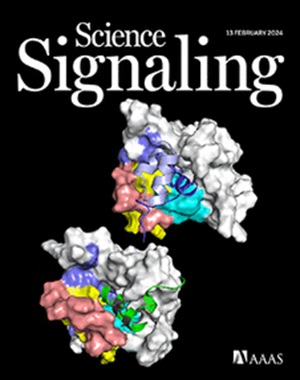异位的刺猬信号轴驱动遗传性多发性骨软骨瘤小鼠模型的定向肿瘤生长
IF 6.6
1区 生物学
Q1 BIOCHEMISTRY & MOLECULAR BIOLOGY
引用次数: 0
摘要
骨软骨瘤是罕见的儿童疾病遗传性多发性骨软骨瘤(HMO)。肿瘤起源于生长板软骨膜,沿骨骼元素,首先表现为异位软骨,然后单向生长,与周围结构发生碰撞和损伤。HMO是由影响硫酸肝素合成酶EXT1或EXT2的突变引起的,导致HS缺乏和HS结合生长因子的异常活性。我们利用生长板和软骨膜条件Ext1缺失的小鼠,研究了HMO肿瘤生长的信号通路和机制。发展中的肿瘤在其软骨部分显示活跃的Hedgehog (Hh)信号,在其远端边缘存在甲状旁腺激素相关蛋白(PTHrP),产生异位的Hh-PTHrP轴,与相邻生长板上指导正常骨延长的轴正交。在Ext1突变体中,Hh信号效应因子Smoothened (Smo)的缺失降低了肿瘤生长,而Smo抑制剂Patched1 (Ptch1)的杂合缺失则增加了肿瘤生长。当Hh信号被阻断时,促进生长板中正常软骨生长的两种hs结合生长因子BMP2和激活素A没有发挥其正常的促软骨生成活性,这表明Hh信号对软骨形成至关重要。总之,我们的研究结果表明,骨软骨瘤篡取生理信号机制来指导和推动其定向生长,使它们能够损害周围组织,并提出了治疗干预的潜在目标。本文章由计算机程序翻译,如有差异,请以英文原文为准。
An ectopic Hedgehog signaling axis drives directional tumor outgrowth in a mouse model of hereditary multiple osteochondromas
Osteochondromas characterize the rare pediatric disorder hereditary multiple osteochondromas (HMO). The tumors originate from the growth plate perichondrium along skeletal elements, appear first as ectopic cartilage, and then grow unidirectionally, colliding with and damaging surrounding structures. HMO is caused by mutations that affect the heparan sulfate (HS) synthases EXT1 or EXT2, leading to HS deficiency and aberrant activity of HS-binding growth factors. We investigated the signaling pathways and mechanisms underlying tumor growth in HMO using mice with conditional Ext1 deficiency in the growth plate and perichondrium. Developing tumors displayed active Hedgehog (Hh) signaling within their cartilaginous moiety and the presence of parathyroid hormone–related protein (PTHrP) at their distal edge, generating an ectopic Hh-PTHrP axis orthogonal to the one directing normal bone lengthening at the adjacent growth plate. In Ext1 mutants, loss of the Hh signaling effector Smoothened (Smo) reduced tumor growth, whereas heterozygous loss of the Smo inhibitor Patched1 (Ptch1) increased tumor growth. Two HS-binding growth factors that promote normal cartilage growth in the growth plate, BMP2 and activin A, did not exert their normal prochondrogenic activity when Hh signaling was blocked, demonstrating that Hh signaling is essential for chondrogenesis. Together, our findings show that osteochondromas usurp a physiological signaling mechanism to guide and propel their directional outgrowth, enabling them to damage surrounding tissues, and suggest potential targets for therapeutic intervention.
求助全文
通过发布文献求助,成功后即可免费获取论文全文。
去求助
来源期刊

Science Signaling
BIOCHEMISTRY & MOLECULAR BIOLOGY-CELL BIOLOGY
CiteScore
9.50
自引率
0.00%
发文量
148
审稿时长
3-8 weeks
期刊介绍:
"Science Signaling" is a reputable, peer-reviewed journal dedicated to the exploration of cell communication mechanisms, offering a comprehensive view of the intricate processes that govern cellular regulation. This journal, published weekly online by the American Association for the Advancement of Science (AAAS), is a go-to resource for the latest research in cell signaling and its various facets.
The journal's scope encompasses a broad range of topics, including the study of signaling networks, synthetic biology, systems biology, and the application of these findings in drug discovery. It also delves into the computational and modeling aspects of regulatory pathways, providing insights into how cells communicate and respond to their environment.
In addition to publishing full-length articles that report on groundbreaking research, "Science Signaling" also features reviews that synthesize current knowledge in the field, focus articles that highlight specific areas of interest, and editor-written highlights that draw attention to particularly significant studies. This mix of content ensures that the journal serves as a valuable resource for both researchers and professionals looking to stay abreast of the latest advancements in cell communication science.
 求助内容:
求助内容: 应助结果提醒方式:
应助结果提醒方式:


